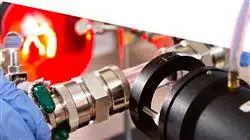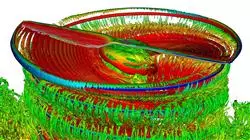University certificate
The world's largest faculty of engineering”
Introduction to the Program
Become an expert in all kinds of CFD Techniques and learn to get the most out of them”

The Finite Volume Method (FVM) is the most widely used method in Computational Fluid Mechanics. But there are alternative techniques that are also very suitable and have more specific applications. To know this series of methods, specific and highly advanced knowledge in this matter is necessary, which has caused companies to increasingly demand expert professionals in this area.
This is the reason why TECH has created a Postgraduate diploma in Unconventional CFD Techniques, with the aim of providing its students with the most complete and up-to-date knowledge, as well as the best skills, so that they can face a professional future in this field, with total guarantee of success. Thus, throughout the agenda, calculation techniques such as Smoothed Particle Hydrodynamics, Monte Carlo Direct Simulation, the Lattice-Boltzmann Method or the aforementioned Finite Element Method are analyzed and addressed, among other topics, such as the Multiphysics Simulations or Numerical Methods and Fundamentals of Fluid Physics.
All this in a comfortable 100% online modality that allows students to combine their studies with their other day-to-day activities, without having to adapt to new schedules or travel. In addition, throughout this degree, the most complete, dynamic and practical content possible is offered, accessible from any device with an Internet connection, be it a tablet, mobile phone or computer.
Strengthen your professional profile with new knowledge in FEM, SPH or DSMC”
This Postgraduate diploma in Unconventional CFD Techniques contains the most complete and up-to-date program on the market. The most important features include:
- The development of practical cases presented by experts in Unconventional CFD Techniques
- The graphic, schematic, and practical contents with which they are created, provide scientific and practical information on the disciplines that are essential for professional practice
- Practical exercises where self-assessment can be used to improve learning
- Its special emphasis on innovative methodologies
- Theoretical lessons, questions for the expert, debate forums on controversial topics, and individual reflection assignments
- Content that is accessible from any fixed or portable device with an Internet connection
Enroll now and access all the content on the Lattice - Boltzmann Method”
The program’s teaching staff includes professionals from the sector who contribute their work experience to this educational program, as well as renowned specialists from leading societies and prestigious universities.
Its multimedia content, developed with the latest educational technology, will provide the professional with situated and contextual learning, i.e., a simulated environment that will provide an immersive education designed to learn in real situations.
The design of this program focuses on Problem-Based Learning, by means of which the professional must try to solve different professional practice situations that are presented throughout the academic course. For this purpose, the student will be assisted by an innovative interactive video system created by renowned experts.
Acquire new skills in the field of Multiphysics Simulations, in a few months and without leaving home"

You will be able to enhance your profile in CFD Techniques, thanks to the most complete theoretical and practical material"
Why study at TECH?
TECH is the world’s largest online university. With an impressive catalog of more than 14,000 university programs available in 11 languages, it is positioned as a leader in employability, with a 99% job placement rate. In addition, it relies on an enormous faculty of more than 6,000 professors of the highest international renown.

Study at the world's largest online university and guarantee your professional success. The future starts at TECH”
The world’s best online university according to FORBES
The prestigious Forbes magazine, specialized in business and finance, has highlighted TECH as “the world's best online university” This is what they have recently stated in an article in their digital edition in which they echo the success story of this institution, “thanks to the academic offer it provides, the selection of its teaching staff, and an innovative learning method aimed at educating the professionals of the future”
A revolutionary study method, a cutting-edge faculty and a practical focus: the key to TECH's success.
The most complete study plans on the university scene
TECH offers the most complete study plans on the university scene, with syllabuses that cover fundamental concepts and, at the same time, the main scientific advances in their specific scientific areas. In addition, these programs are continuously being updated to guarantee students the academic vanguard and the most in-demand professional skills. In this way, the university's qualifications provide its graduates with a significant advantage to propel their careers to success.
TECH offers the most comprehensive and intensive study plans on the current university scene.
A world-class teaching staff
TECH's teaching staff is made up of more than 6,000 professors with the highest international recognition. Professors, researchers and top executives of multinational companies, including Isaiah Covington, performance coach of the Boston Celtics; Magda Romanska, principal investigator at Harvard MetaLAB; Ignacio Wistumba, chairman of the department of translational molecular pathology at MD Anderson Cancer Center; and D.W. Pine, creative director of TIME magazine, among others.
Internationally renowned experts, specialized in different branches of Health, Technology, Communication and Business, form part of the TECH faculty.
A unique learning method
TECH is the first university to use Relearning in all its programs. It is the best online learning methodology, accredited with international teaching quality certifications, provided by prestigious educational agencies. In addition, this disruptive educational model is complemented with the “Case Method”, thereby setting up a unique online teaching strategy. Innovative teaching resources are also implemented, including detailed videos, infographics and interactive summaries.
TECH combines Relearning and the Case Method in all its university programs to guarantee excellent theoretical and practical learning, studying whenever and wherever you want.
The world's largest online university
TECH is the world’s largest online university. We are the largest educational institution, with the best and widest online educational catalog, one hundred percent online and covering the vast majority of areas of knowledge. We offer a large selection of our own degrees and accredited online undergraduate and postgraduate degrees. In total, more than 14,000 university degrees, in eleven different languages, make us the largest educational largest in the world.
TECH has the world's most extensive catalog of academic and official programs, available in more than 11 languages.
Google Premier Partner
The American technology giant has awarded TECH the Google Google Premier Partner badge. This award, which is only available to 3% of the world's companies, highlights the efficient, flexible and tailored experience that this university provides to students. The recognition as a Google Premier Partner not only accredits the maximum rigor, performance and investment in TECH's digital infrastructures, but also places this university as one of the world's leading technology companies.
Google has positioned TECH in the top 3% of the world's most important technology companies by awarding it its Google Premier Partner badge.
The official online university of the NBA
TECH is the official online university of the NBA. Thanks to our agreement with the biggest league in basketball, we offer our students exclusive university programs, as well as a wide variety of educational resources focused on the business of the league and other areas of the sports industry. Each program is made up of a uniquely designed syllabus and features exceptional guest hosts: professionals with a distinguished sports background who will offer their expertise on the most relevant topics.
TECH has been selected by the NBA, the world's top basketball league, as its official online university.
The top-rated university by its students
Students have positioned TECH as the world's top-rated university on the main review websites, with a highest rating of 4.9 out of 5, obtained from more than 1,000 reviews. These results consolidate TECH as the benchmark university institution at an international level, reflecting the excellence and positive impact of its educational model.” reflecting the excellence and positive impact of its educational model.”
TECH is the world’s top-rated university by its students.
Leaders in employability
TECH has managed to become the leading university in employability. 99% of its students obtain jobs in the academic field they have studied, within one year of completing any of the university's programs. A similar number achieve immediate career enhancement. All this thanks to a study methodology that bases its effectiveness on the acquisition of practical skills, which are absolutely necessary for professional development.
99% of TECH graduates find a job within a year of completing their studies.
Postgraduate Diploma in Unconventional CFD Techniques
.
The use of simulation techniques in Engineering is becoming more and more common in different areas, including fluid dynamics simulation (CFD). The current technological development allows the realization of increasingly accurate simulations, which has allowed the exploration of new unconventional CFD techniques that seek to solve complex problems in the field of engineering. At TECH Global University, we offer the Postgraduate Diploma in Unconventional CFD Simulation Techniques, designed for professionals who seek to expand their knowledge in this field and apply innovative techniques in their projects.
In this Postgraduate Diploma program, you will learn how to develop and apply innovative CFD techniques to solve complex engineering problems.
In this program, we will study unconventional CFD techniques in depth, such as multiphase flow simulation, turbulence simulation, interface modeling and non-Newtonian fluid simulation. In addition, the development of advanced simulation and programming techniques with specialized software tools is addressed, allowing students to apply the knowledge acquired in solving real problems in the engineering area. Similarly, the program has a methodology that combines theoretical and practical classes, allowing students to apply the concepts learned in real projects and cases, in search of innovative solutions that add value to the industry.







